1996 PONTIAC GRAND-AM steering wheel
[x] Cancel search: steering wheelPage 87 of 356

Tilt Wheel (Option)
A tilt steering wheel allows you to adjust the steering
wheel before you drive.
You can also raise it to the highest level to give your
legs more room when
you exit and enter the vehicle.
To tilt the wheel, hold the steering wheel and pull the
lever. Move the steering wheel to a comfortable level,
then release the lever to lock the wheel in place.
Turn SignallMultifunction Lever
The lever on the left side of the steering column
includes your:
Turn Signal and Lane Change Indicator
0 Headlamp High/Low Beam Changer
0 Cruise Control (Option)
2-31
ProCarManuals.com
Page 107 of 356

Your instlument panel is designed to let you know at a
glance how your vehicle is running. You’ll know how
fast you’re going,
how much fuel you’re using, and
many other things you’ll need to drive safely and
economically.
The main components of your instrument panel are:
A. Fuse Panel
B. Vent
C. Turn Signal/Multifunction ,Lever
D. SRS - Supplemental Restraint System (Air Bag)
E. Hazard Warning Flashers Switch
E Instrument Cluster
G. Windshield Wipersmasher Stalk
H. Audio System
I. Side Window Defogger Vent
J. Glove Box
K. Climate Control System
L. Gear Shift Lever
M. Ashtray
N. Enhanced Traction System (ETS) Switch (Option)
0. Lighter
P. Ignition Switch
Q. Tilt Steering Wheel Lever (Option)
R. Fog Lamp Switch
S. Instrument Panel Intensity Control/ Interior Lamps
Switch
T. Hood Release Handle
2-51
ProCarManuals.com
Page 145 of 356
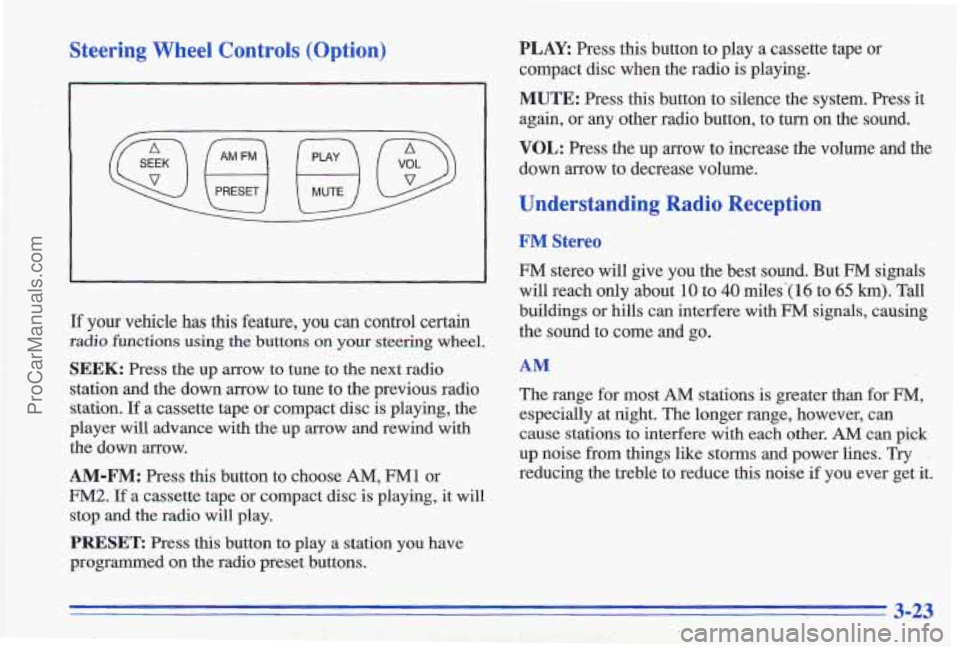
Steering Wheel Controls (Option)
.-
\u u/
If your vehicle has this feature, you can control certain
radio functions using the buttons on your steering wheel.
SEEK: Press the up arrow to tune to the next radio
station and the down
arrow to tune to the previous radio
station.
If a cassette tape or compact disc is playing, the
player will advance with the up arrow
and rewind with
the down arrow.
AM-FM: Press this button to choose AM, FM1 or
FM2. If a cassette tape or compact disc is playing, it will
stop and the radio will play.
PRESET Press this button to play a station you have
programmed on the radio preset buttons.
PLAY Press this button to play a cassette tape or
compact disc when the radio
is playing.
MUTE: Press this button to silence the system. Press it
again, or any other radio button, to turn on the sound.
VOL: Press the up arrow to increase the volume and the
down arrow to decrease volume.
Understanding Radio Reception
FM Stereo
FM stereo will give you the best sound. But FM signals
will reach only about
10 to 40 miles-( 16 to 65 km). Tall
buildings or hills can interfere with
FM signals, causing
the sound to come and
go.
AM
The range for most AM stations is greater than for FM,
especially at night. The longer range, however, can
cause stations to interfere with each other.
AM can pick
up noise from things like storms and power lines. Try
reducing the treble to reduce this noise
if you ever get it.
3-23,
ProCarManuals.com
Page 158 of 356
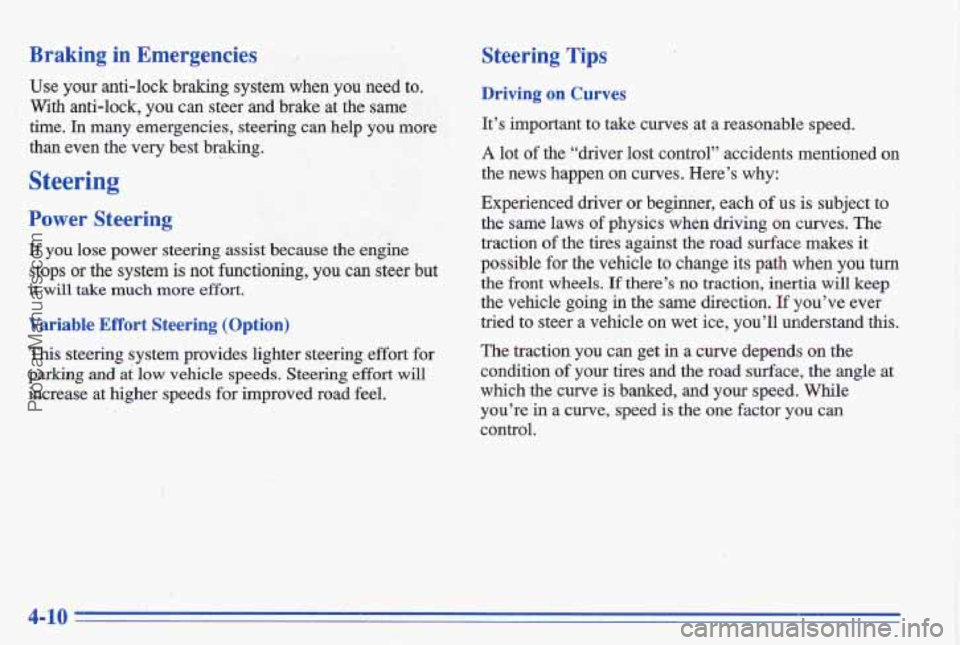
Braking in Emergencies
Use your anti-lock braking system when you need to.
With anti-lock, you can steer and brake at the same
time. Tn many emergencies, steerirzg’cm help you more
thin even the very best braking. -
Steering
Power Steering
If you lose power steering assist because the engine
stops or the system is not functioning,
you can steer but
it will take much more effort.
Variable Effort Steering (Option)
This steering system provides lighter steering effort for
parlcitlg ad at low vehicle speeds. Steering effurt will
increase at higher speeds for improved road feel.
Steering Tips
Driving on Curves
It’s important to take curves at a reasonable speed.
A lot of the “driver lost control” accidents mentioned on
the news happen on curves. Here’s why:
Experienced driver or beginner, each of us is subject to
the same laws
of physics when driving on curves. The
traction
of the tires against the road surface makes it
possible
for the vehicle to change its path when you turn
the front wheels.
If there’s no traction, inertia will keep
the vehicle
going in the same direction. If you’ve ever
tried
to steer a vehicle on wet ice, you’ll understand this.
The traction you can get
in a curve depends on the
condition
of your tires and the road surface, the angle at
which the curve is banked,
and your speed. While
you’re
in a curve, speed is the one factor you can
control.
4-10,
ProCarManuals.com
Page 159 of 356
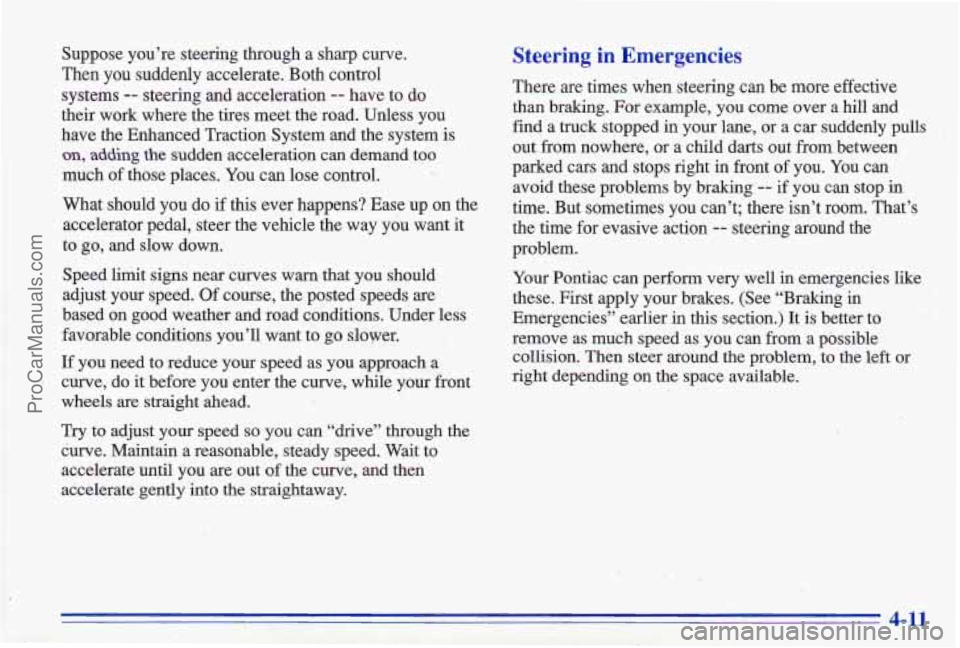
Suppose you’re steering through a sharp curve.
Then you suddenly accelerate. Both control systems
-- steering and acceleration -- have to do
their work where the tires meet the road. Unless you
have the Enhanced Traction System and the system
is
on, adding the sudden acceleration can demand too
much of those places. You can lose control.
What should you do
if this ever happens? Ease up on the
accelerator pedal, steer the vehicle the way you want it
to
go, and slow down.
Speed limit signs near curves warn that you’should
adjust your speed. Of course, the posted spe,eds are
based on good weather and road conditions. Under less
favorable conditions you’ll want to
go slower.
If you need to reduce your speed as you approach a
1 curve, do it before you enter the curve, while your front
wheels are straight ahead.
Try to adjust your speed
so you can “drive” through the
curve. Maintain a reasonable, steady speed. Wait to
accelerate until you are out of the curve,
and then
accelerate gently into the straightaway.
Steering in Emergencies
There are times when steering can be more effective
than braking. For example, you come over a hill and
find a truck stopped in your lane, or a car suddenly pulls
out from nowhere, or a child darts out from between
parked cars and stops right in front
of you. You can
avoid these problems by braking
-- if you can stop in
time. But sometimes you can’t; there isn’t room. That’s\
the time for evasive action
-- steering around the
problem.
Your Pontiac can perform very well
in emergencies like
these.
First apply your brakes. (See “Braking in
Emergencies” earlier in this section.) It is better to
remove as much speed as you can from a possible
collision. Then steer around the problem, to the left or
right depending on the space available.
1 :
4-11
ProCarManuals.com
Page 160 of 356
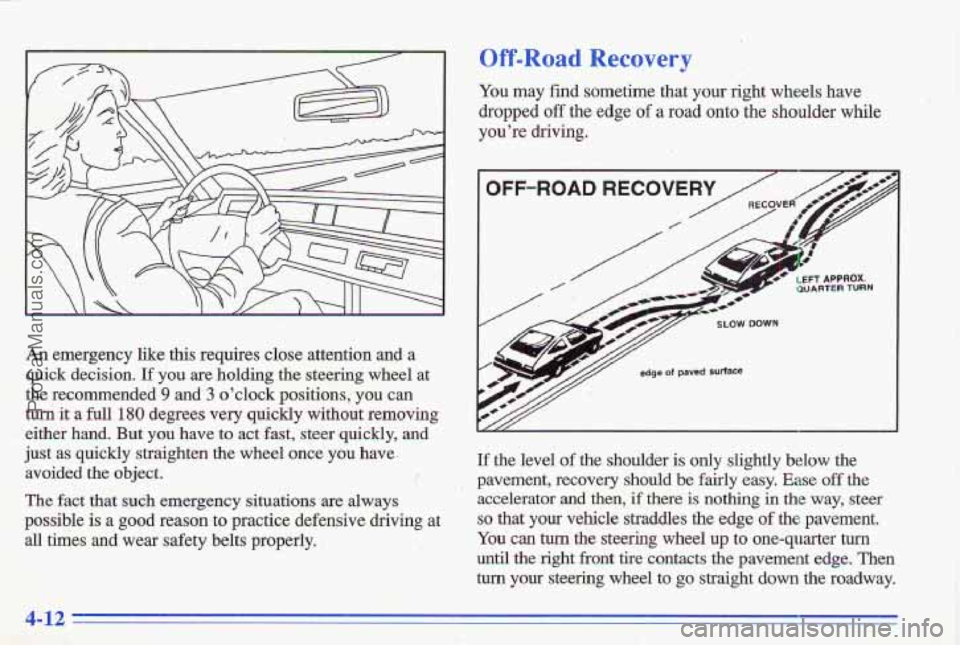
An emergency like this requires close attention and a
quick decision.
If you are holding the steering wheel at
the recommended 9 and' 3 o'clock positions, you can
turn it a full 180 degrees very quickly without removing
either hand. But you have to act ,fast, steer quickly, and
just as quickly straighten the wheel once
you have.
avoided the object.
,(
The fact that such emergency situations are always
possible is a good reason to practice defensive driving at
all times and wear safety belts properly.
..._ - '
Off-Road Recovwy ,. t
', %
You may find sometime that your right wheels have
dropped
off the edge of a road onto the shoulder while
you're
driving.
OFF-RUAD RECOVERY
/- / ,zl I I
-/// edge of paved surface
I
If the level of the shoulder is only slightly below the
pavement, recovery should
be fairly easy. Ease off the
accelerator
and then, if there is nothing in the way, steer
so that your vehicle straddles the edge of the pavement.
You can turn the steering wheel up to one-quarter turn
until the right front tire contacts the pavement edge. Then
turn your steering wheel to go straight down the roadway.
4-12
ProCarManuals.com
Page 162 of 356
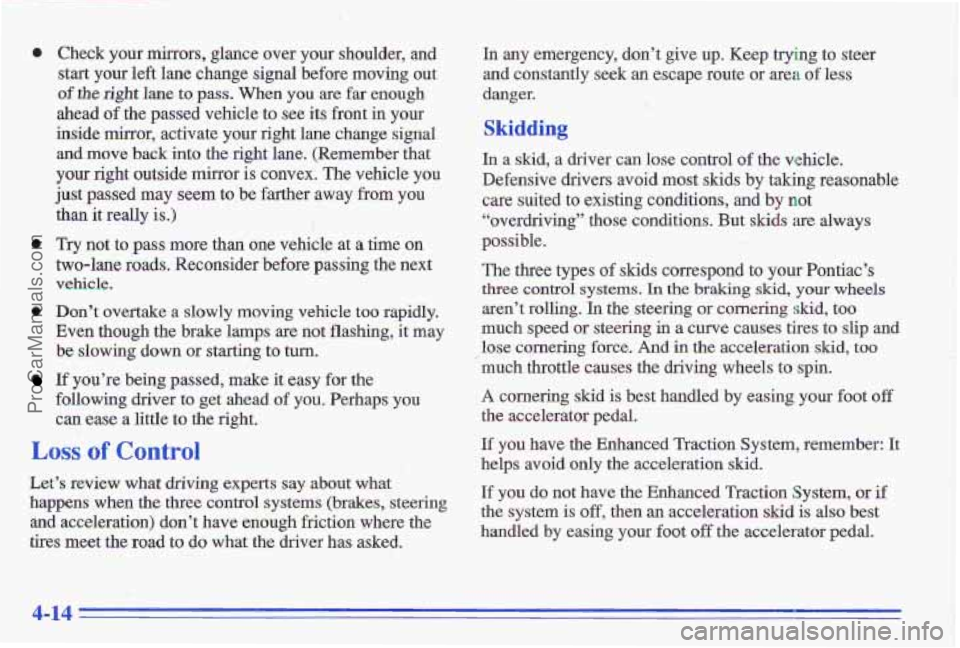
0
0
a
Check your mirrors, glance over your shoulder, and start your left lane change signal before moving out
of the right lane to pass. When you are far enough
ahead
of the passed vehicle to see its front in your
inside mirror, activate your right lane change signal and move back into the right lane. (Remember that
your right outside mirror
is convex. The vehicle you
just passed may seem
to be farther away from you
than it redly is.)
Try not to pass more than one vehicle at a time on
two-lane roads. Reconsider
before passing the next
vehicle.
Don’t overtake a slowly moving vehicle too rapidly.
Even though the brake lamps are not flashing, it may
be slowing down or starting to turn.
If you’re being passed, make it easy for the
following driver to get ahead of you. Perhaps you
can ease a little to the right.
In any emergency, don’t give up. Keep trying to steer
and constantly seek
an escape route or area of less
danger.
Skidding
In a skid, a driver can lose control of the vehicle.
Defensive drivers avoid most skids by
taking reasonable
care suited
to existing conditions, and by not
“overdriving” those conditions. But skids are always
possible.
The three types
of skids correspond to your Pontiac’s
three control systems. In the braking skid, your wheels
aren’t rolling. In the steering or cornering skid, too
much speed or steeiing
in a curve causes tires to slip and
lose cornering force. And
in the acceleration skid, too
much throttle causes the driving wheels to spin.
A cornering
skid is best handled by easing your foot off
the accelerator pedal.
If you have the Enhanced Traction System, remember: It
helps avoid only the acceleration skid.
If you do not have the Enhanced Traction System, or if
the system is off, then an acceleration skid is also best
handled by easing your foot
off the accelerator pedal.
Loss of Control
Let’s review what driving experts say about what
happens
when the three control systems (brakes, steering
and acceleration) don’t have enough friction where the
tires meet the road to do what the driver has asked.
4-14
ProCarManuals.com
Page 178 of 356
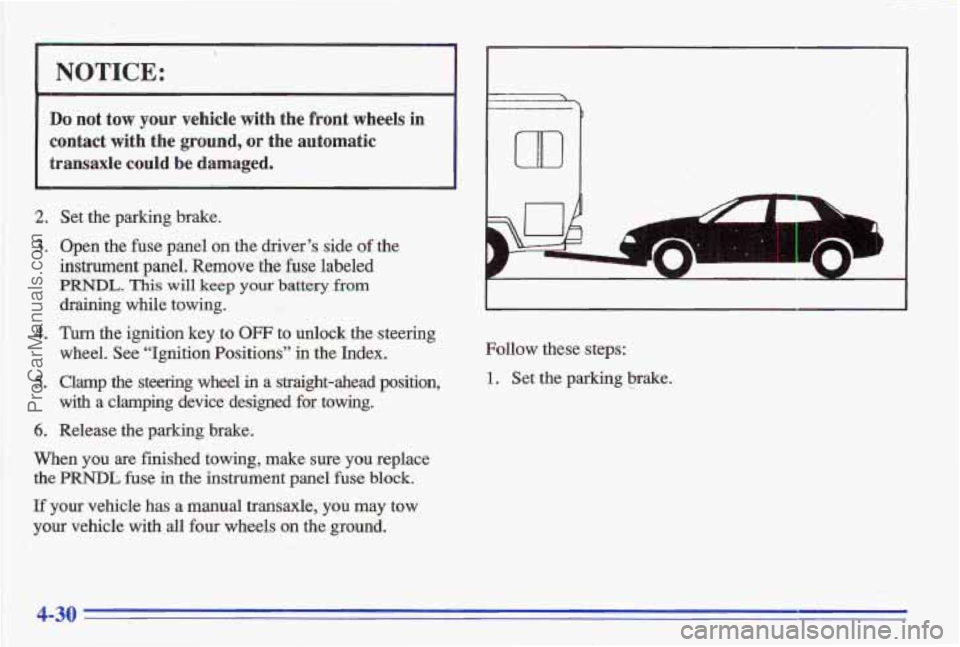
NOTICE:
Do not tow your vehicle with the front wheels in
contact with the
ground, or the automatic
transaxle
could be damaged.
2. Set the parking brake.
3. Open the fuse panel on the driver’s side of the
instrument
panel. Remove the fuse labeled
PRNDL. This will keep your battery from
draining while towing.
wheel. See “Ignition Positions”
in the Index.
with
a clamping device designed for towing.
4. Turn the ignition key to OFF to unlock the steering
5. Clamp the steering wheel in a straight-ahead position,
6. Release the parking brake.
When you are finished towing, make sure you replace
the PRNDL fuse in the instrument panel fuse block.
If your vehicle has a manual transaxle, you may tow
your vehicle with all four wheels on the ground.
m
Follow these steps:
1. Set the parking brake. .
4-30
ProCarManuals.com